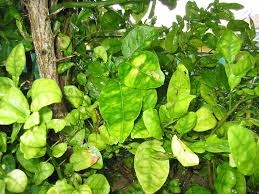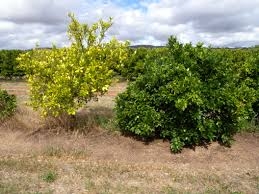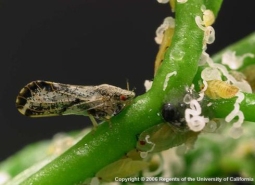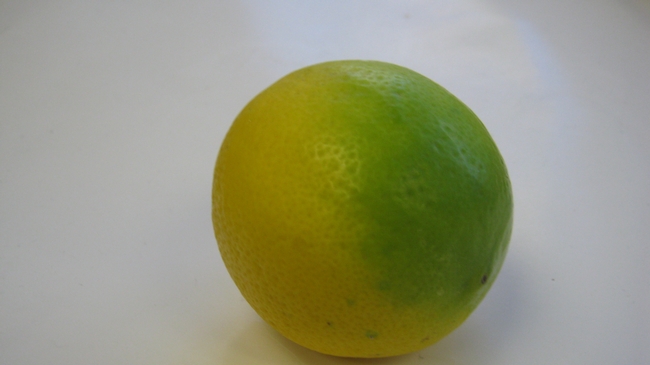- Author: Jeanette Warnert
Newly appointed UC Cooperative Extension agricultural engineering advisor Alireza Pourreza has been awarded the 2016 Giuseppe Pellizzi Prize by the Club of Bologna, an honor presented every other year to the best doctoral dissertations focused on agricultural machinery and mechanization. The Club of Bologna is a world taskforce on strategies for the development of agricultural mechanization.
Pourreza, who earned his Ph.D. at the University of Florida in 2014, worked on early detection of Huanglongbing disease of citrus. Huanglongbing, an incurable disease that is spread by Asian citrus psyllid, has seriously impacted citrus production in Florida. The disease has been found in commercial and residential sites in all counties with commercial citrus.
Early detection allows growers to remove infected trees before the disease can spread to healthy trees. Currently HLB infection is confirmed when leaves with yellowing and blotches are submitted for PCR testing, which is expensive and time consuming. However, the yellowing can be also symptomatic of other conditions, such as nutrient deficiency.
“We discovered we could see the symptoms of Huanglongbing using a camera, a set of cross-polarizers and narrow band lighting before it is visible to the human eye,” Pourreza said.
He said the yellow blotches on HLB-infected leaves are caused by starch accumulation.
“If we could detect abnormal levels of starch in the leaf, we could tell it is affected with HLB,” Pourreza said. “Starch showed the ability to rotate the polarization plain of light. We used this optical characteristic to develop the sensing methodology.”
Pourreza said the team has patented the technique and is working on developing a commercial product. He is seeking funding to continue the research in California, where, to date, HLB has only been detected in isolated Los Angeles neighborhoods. Asian citrus psyllid is found in important California commercial citrus production regions from the Mexican border to as far north as Placer County.
Pourreza is based at the UC Kearney Agricultural Research and Extension Center in Parlier.

- Author: Ben Faber
Entomology Specialist and Lindcove Research and Education Center Director keeps her Asian Citrus Psyllid website for homeowners up-to-date at: http://ucanr.edu/sites/ACP/Homeowner_Options/Homeowner_Resources/
Check it out.
Photo: ACP Adult and Nymphs with wax tubules

- Author: Ben Faber
What this means is that there is different feeding behavior on different scion varieties that is unaffected by the rootstocks used in this study. This does not mean "a" rootstock can not have an effect, just that the ones used in this trial did not.
EFFECT OF DIFFERENT CITRUS SCION AND ROOTSTOCKS
COMBINATION ON FEEDING OF Diaphorina citri
Alves GA1, Beloti VH1, Carvalho SA2 & Yamamoto PT1
1Escola Superior de Agricultura ‘Luiz de Queiroz'/
Universidade de São Paulo, Piracicaba, SP, Brazil; 2Instituto
Agronômico (IAC), Centro de Citricultura, Cordeirópolis, SP,
Brazil; e-mail: gralves@usp.br
The Asian citrus psyllid (ACP) is the vector of bacteria associated to the huanglongbing and has a host range of more than 50 species of the Rutaceae family. The knowledge about the feeding behavior in different hosts can show useful aspects for future studies of plant resistance and ACP management. Therefore, was evaluated the effect of different combinations of scion and rootstock of citrus in the feeding of ACP adults. For this, we tested Valencia, Pera and Hamlin sweet orange, Ponkan mandarin and Sicilian lemon grafted on Rangpur lime and Sunki mandarin rootstocks.
The flushes were individualized with cages made of transparent plastic cup and “voile” tissue. To collect the honeydew, discs of filter paper were placed at the base of each flush. The adults fed for a period of 72 h. After this, the discs were removed and immersed on the ninhydrin solution. After 24 h, the drops area of honeydew was determined using the Quant software. The feeding was more intense on sweet orange varieties, with a highest value observed to Valencia (0.902 cm2) and the smaller area to Ponkan mandarin(0.269 cm2). Unlike observed for scion varieties, when different rootstocks for the same scion variety were tested, no difference was observed in the consumption of ACP.
Rootstocks can have a tremendous effect, but not in this case with the rootstocks used

- Author: Nastaran Tofangsazi and Beth Grafton-Cardwell, Department of Entomology, UC Riverside
With the detection of Huanglongbing (HLB) in California in 2012 and 22 additional cases reported during 2015 through June 2016 there is a major concern among citrus growers about the spread of this incurable bacterial disease. The vector of the disease, the Asian citrus psyllid (ACP), is a hardy insect with good dispersal capabilities and can be found in many southern California citrus groves today. With no direct cure for HLB at present, the only option for growers to combat the disease is to control the psyllid. This can prove difficult for conventional citrus growers with broad spectrum insecticides, but for organic citrus growers, which grow an estimated 7% of citrus in California, the task is even more difficult with the currently available options.
Entrust (spinosad) + oil, Pyganic (pyrethrin) + oil, and oil alone are currently the recommended and most widely used insecticide options for organic growers (UC IPM Guidelines for Citrus). While these insecticides are fairly effective in killing ACP if they make direct contact, the residual life of these pesticides is very short (days) compared to conventional insecticides (weeks to months). For example, in our petri dish studies, 10 fl oz/acre Entrust SC + 0.25% Omni supreme spray oil caused 89% mortality, 17 fl oz/acre Pyganic 5.0 EC + 0.25% Omni supreme spray oil caused 73% mortality and 0.25% Omni supreme spray oil caused 42% mortality when 1st-2nd ACP nymphs were exposed to treated leaves one day after application. Nymphal mortality continued to decline for the Entrust + oil treatment (69% mortality) and even more severely declined for Pyganic + oil (27% mortality) 3 days after treatment. In contrast, one-day-old residues of a conventional insecticide, the neonicotinoid 5.5 oz Actara (thiamethoxam), resulted in more than 95% mortality of nymphs and mortality remained high for more than a month.
Studies of grower orchard treatments confirmed laboratory studies that showed a short residual effect of organic treatments (Entrust + oil and oil alone) compared to conventional insecticides (Actara). We monitored changes in population densities of ACP (adults by tap, nymphs and eggs by flush examinations) in the fall of 2015 before and after a grower sprayed separate orchards with one of three insecticides; 1) 1.25% 440 Supreme Spray Oil by ground application (400 gpa), or 2) 9 fl oz Entrust SC + 1% oil by air (50 gpa), or 3) 5.5 oz Actara by air (50 gpa). The oil treatment had little effect on the adult population, but significantly reduced psyllid nymph densities for 17-24 days. Entrust was completely ineffective in controlling psyllid nymphs, but suppressed adult and egg populations for about 14 days. Actara, a conventional insecticide, was the most effective treatment in the study and provided more than 5 weeks of both adult and nymph control. Because of the short residual effect of organic insecticides in citrus, repeat treatments are needed at a frequency of about every 2 weeks for ACP control.
Tamarixia radiata wasps released for biological control of ACP provide 20% to 88% parasitism depending on geographical location and time of year. If there were no disease to be concerned about, this level of parasitism by Tamarixia would be sufficient to protect citrus from the feeding damage of the psyllid. However, the disease spreads rapidly with just a few psyllids and so a greater level of control is needed. Generalist predators, such as lady beetles, lacewings and assassin bugs, also assist with control. Argentine ants can severely disrupt this parasitism by protecting psyllids from natural enemies. Unhappily, Entrust + oil, thought of as a very selective insecticide combination, was found to be highly toxic to adult Tamarixia wasps exposed to 3 day old residues. Thus, the organic insecticide that is the best for controlling the psyllid pest is not compatible with the parasitoid natural enemy, limiting our ability to use integrated strategies to control the psyllid.
At present, it is not mandatory, but is strongly recommended, that all southern California citrus growers treat their orchards in an area wide manner. The area wide program consists of coordinated treatments twice a year (winter and fall), and additional treatments in between. Due to the short residual nature of organic insecticides, organic applications should be applied twice within 10-14 days of each other for every single conventional insecticide application. This is especially important for younger groves as ACP nymphs thrive in new flush. Organic growers have a tough decision to make between treating frequently for ACP and the high cost associated with those treatments or transitioning into conventional management in order to more effectively control ACP. Additional solutions are needed for organic citrus.
UC IPM Guidelines for Citrus: Asian Citrus Psyllid. http://ipm.ucanr.edu/PMG/r107304411.html

- Author: Ben Faber
Beth Grafton-Cardwell our IPM Specialist who is Lindcove Research and Extension Director and a UC Riverside Entomologist recently gave a talk on the different approaches being taken to confront Asian Citrus Psyllid and Huanglongbing. A summary of a lot of her points is available at:
http://ucanr.edu/repositoryfiles/ACP_Fact_Sheet-101755.pdf
She brought up some points that I think need to be better known. Some early detection techniques are being developed so that infected trees can be quickly identified and removed so that they do serve as a reservoir of inoculum that can increase the spread of the bacterial disease. These techniques are based on measureable levels of different chemicals.
-
Sick trees produce different volatiles (Volatile Organic Compounds can be “sniffed” by machines or trained dogs)
-
Sick trees produce proteins that can be measured
-
Trees produce small RNAs in their defense response that can be measured
-
The bacteria produce proteins that can be measured
-
The micro-organisms associated with sick trees are different than those associated with healthy trees and these can be measured.
All of these techniques are being tested out right now and being refined. It will mean faster diseased tree identification and removal. This will still mean chemical control of the psyllid to control disease spread.
Early detection is just one of the techniques being employed to fight this insect/disease complex. Every conceivable possibility is being explored, including:
-
Psyllid traps – attract and kill
-
Psyllid deterrents – chemicals that would drive psyllids away from citrus
-
Antibiotic treatments to control the tree infection
-
Heat treating trees to destroy the bacteria in the tree
-
Resistant rootstocks and scions (traditional breeding and genetic engineering)
-
Utilize an altered citrus tristeza virus to introduce anti-HLB genes into plants (Genetically Engineered)
-
Altering the psyllid so it can't vector the disease and releasing the ‘nupsyllid' to replace the wild ones (GE)
-
Treat trees with chemicals (interference RNAs) that prevent the psyllid from picking up the disease
Wow. Many of these are a long way off, but some might be coming out soon. We still need to deal with the psyllid so that when infected insects become more widespread, the disease will not spread as fast as it has in Florida and other citrus growing areas.




